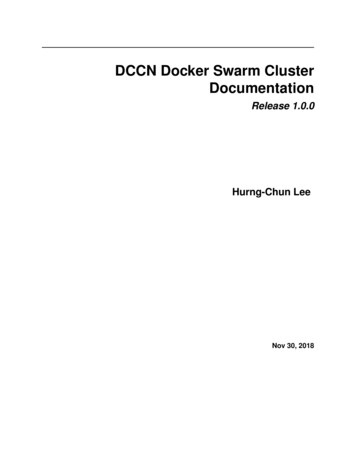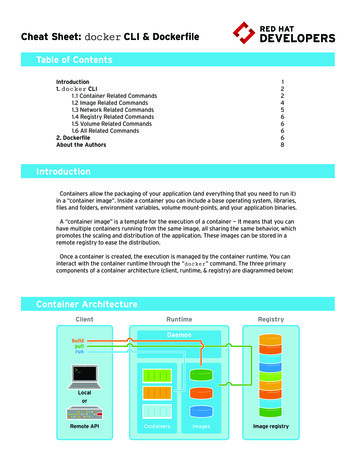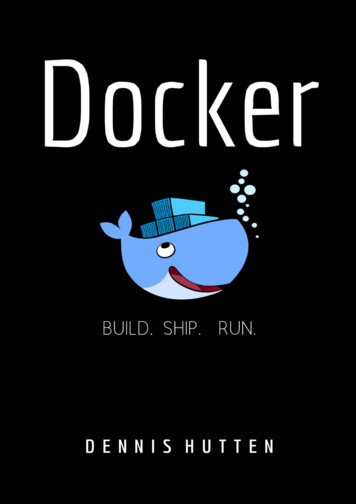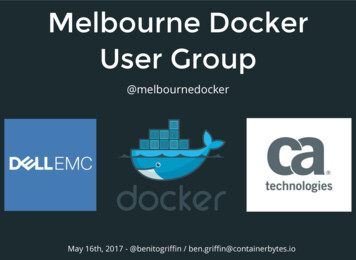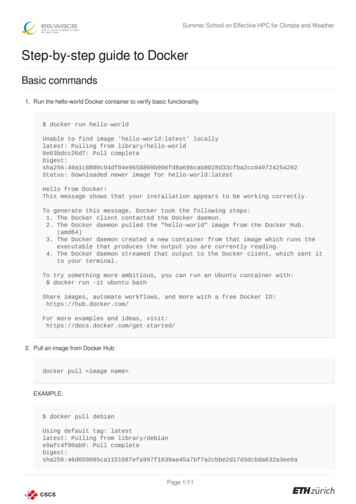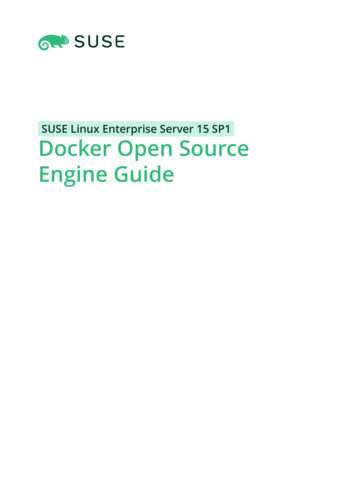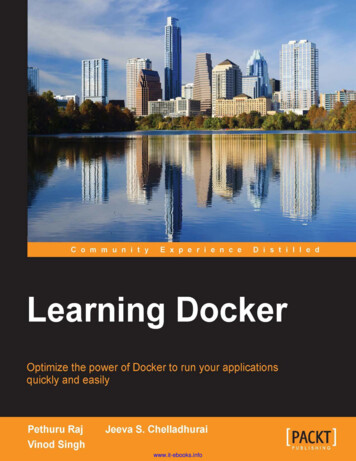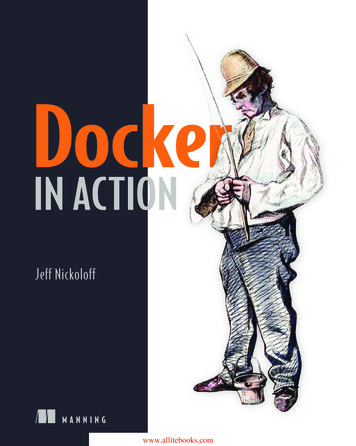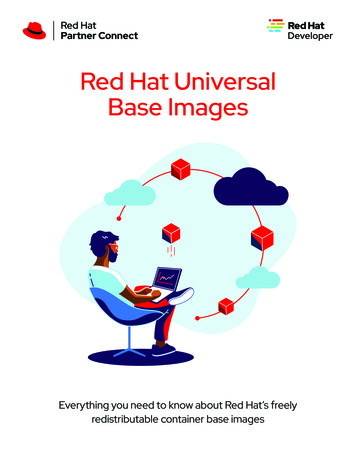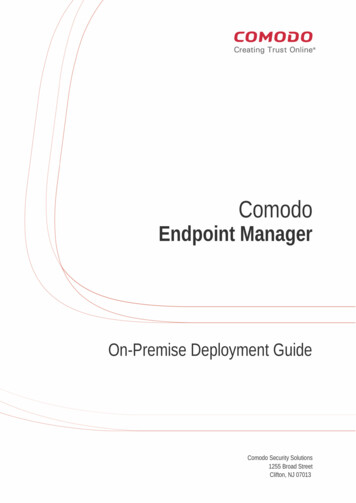
Transcription
Introduction to containers and DockerSummer School on Effective HPC for Climate and WeatherAlberto Madonna, CSCSAugust 26, 2021
Table of Contents1.Introduction to containers and Docker (20 min)2.Docker tutorial / live demo (50 min)3.Overview of containers in HPC (15 min)- Break -4.Lab session (1h30m) Slides and code available at https://github.com/eth-cscs/containers-hands-on Lab tutorial video: https://youtu.be/dv74sFb3cVc Disclaimer: This material reflects only the author’s view and the EU-Commissionis not responsible for any use that may be made of the information it containsIntroduction to Containers and Docker2
Containers Isolated environments to run applications/services Images include all software dependencies Prescriptive, portable, easy to build, quick to deployImage credit: Docker Inc.Introduction to Containers and Docker3
Key terms Image: standalone, executable package that includes everything needed to runa piece of software (code, runtime libraries, configuration files). Provides thefilesystem and metadata (e.g. environment variables, initial working directory) fora container. Container: a process isolated from the rest of the system through abstractionscreated by the OS. The level of isolation can be controlled, allowing access tohost resources. Its filesystem content comes from an image. Can be thought as the runtime instance of an image: what the image becomes in memorywhen actually executed.Introduction to Containers and Docker4
Linux containers ecosystem Linux containers rely on abstraction features (namespaces1) provided by the kernel Different design decisions and use cases gave rise to several solutions:HPC focusedLXCSingularity1“Namespaces in operation, part 1: namespaces overview” at https://lwn.net/Articles/531114/Introduction to Containers and Docker5
Docker Extremely popular container implementation Easy to use authoring tools Container images are created from recipe-like files Images can be named, tagged and built on top of other images Cloud-based image distribution strategy Several remote registries available (e.g. Docker Hub) Client includes facilities to authenticate, push and pull imagesIntroduction to Containers and Docker6
Docker workflow1.An image is created locally from a Dockerfile2.Push (i.e. upload) the image to a remote registryDockerHub is the public registry maintained by the Docker company3.Pull (i.e. download) the image on a target machine and run the containerIntroduction to Containers and Docker7
So how are containers useful? Containers give the possibility to create (scientific) applications that are:1. Portable2. Prescriptive3. Easy to deploy4. Easy to testIntroduction to Containers and Docker8
Live demo!
Using NVIDIA GPUs in DockerGPU-accelerated applicationGPU driver Included/built in the image, along with itsruntime dependencies It is tied to the hardware: cannot be part of aportable image! NVIDIA provides base images for CUDA,featuring compilers, runtime and ia/cuda Has to be imported upon container creation NVIDIA Container Toolkit to the rescue!https://github.com/NVIDIA/nvidia-docker Quickest way to get a Dockerfile going:FROM nvidia/cudaIntroduction to Containers and Docker Docker 19.03 has native support:docker run --gpus all nvidia/cuda nvidia-smi10
Containers in HPC
Docker and HPC: not a good fit Security model assumes root privileges No integration with workload managers Missing support for diskless nodes Very limited support for kernel bypassing devices (e.g. accelerators and NICs) No adequate parallel storage driverIntroduction to Containers and Docker12
HPC-focused container software Enabling execution of containers complying with the peculiarities of HPC rIntroduction to Containers and Docker13
Sarus container engine Combines container portability with native HPC performance Integrates with HPC infrastructure and software Customizes containers at runtime with standard plugins Pulls regular Docker images Provides a Docker-like command line interfaceIntroduction to Containers and Docker14
Further material & contact Slides and Lab material: https://github.com/eth-cscs/containers-hands-on Lab intro video: https://youtu.be/dv74sFb3cVc Official Docker documentation: https://docs.docker.com/ Best practices for writing p-images/dockerfile best-practices/ Contact: alberto.madonna@cscs.chIntroduction to Containers and Docker15
The ESiWACE1/2 projects have received funding from the European Union’sHorizon 2020 research and innovation programme under grant agreementNo 675191 and No 823988Disclaimer: This material reflects only the author’s view and the EU-Commission is not responsiblefor any use that may be made of the information it containsIntroduction to Containers and Docker16
Thank you for your attention.
Break time! Back at 15.30 CEST
Lab session Slides and material: https://github.com/eth-cscs/containers-hands-on Intro video: https://youtu.be/dv74sFb3cVc Quickstart:1. git clone t2. cd containers-hands-on/esiwace2-summer-school-20213. Open docker-step-by-step.pdf documentIntroduction to Containers and Docker19
Backup slides
Docker cheatsheetdocker pull user/image:tag docker run image:tag command docker run –it image:tag bashdocker run image:tag mpirun –n 2docker imagesdocker build –t user/image:tag .docker logindocker push user/image:tag Introduction to Containers and Docker21
Open docker-step-by-step.pdf document Introduction to Containers and Docker 19. Backup slides. Docker cheatsheet Introduction to Containers and Docker 21 docker pull user/image:tag docker run image:tag command docker run -it image:tag bash docker run image:tag mpirun -n 2

